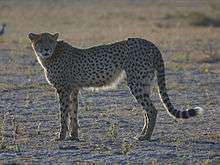Acinonyx
| Acinonyx | |
|---|---|
 | |
| Cheetah, Acinonyx jubatus | |
| Scientific classification | |
| Kingdom: | Animalia |
| Phylum: | Chordata |
| Class: | Mammalia |
| Order: | Carnivora |
| Suborder: | Feliformia |
| Family: | Felidae |
| Subfamily: | Felinae |
| Tribe: | Acinonychini |
| Genus: | Acinonyx Brookes, 1828 |
| Species | |
| |
| Synonyms | |
|
Cynailurus Wagner, 1830 | |
Acinonyx is a genus within the cat family.[1] The only living species of this genus, the cheetah, A. jubatus, occurs and thrives in open grasslands of Africa and Asia.[2] Though often described as a big cat, this term is used primarily to describe cats of the genus Panthera, ruling out the cheetah.
Historical range
Several other species of cheetah-like cats existed since the late Pliocene epoch but are extinct today.[3] These cats occurred in Africa, parts of Europe and Asia about 10,000 years ago. Several similar species, classified in the genus Miracinonyx, lived in North America at the same time; these may have been more closely related to pumas.[4]
Taxonomy
Acinonyx was first described by Brookes in 1828. In 1993, it was placed in a monophyletic subfamily, Acinonychinae. Molecular phylogenetic analysis has shown that it is the sister group of the genus Puma, and it is now placed within the subfamily Felinae.[1]
Species
Several fossil Acinonyx species in addition to the living cheetah have been described:
- Acinonyx jubatus — by Schreber in 1775[5]
- Acinonyx jubatus jubatus - by Schreber in 1775
- Acinonyx jubatus raineyi - by Heller in 1913
- Acinonyx jubatus soemmeringii - by Fitzinger in 1855
- Acinonyx jubatus hecki - by Hilzheimer in 1913
- Acinonyx jubatus venaticus - by Griffith in 1821
- Acinonyx pardinensis †, the giant cheetah — by Croizet et Jobert in 1828[6]
- Acinonyx intermedius † — by Thenius in 1954[7]
- Acinonyx aicha † — by Geraads in 1997[8]
- "Acinonyx kurteni"† — by Christiansen and Mazák in 2008[9] The "Linxia Cheetah" was originally described from a skull from Pliocene strata in China, and touted as the most primitive member of the genus. In 2012, A. kurteni was invalidated as a species when the holotype was determined to be a forgery composed of Miocene-aged fragments.[10][11]
See also
- American cheetahs of the related genus Miracinonyx
References
- 1 2 Wozencraft, W.C. (2005). "Order Carnivora". In Wilson, D.E.; Reeder, D.M. Mammal Species of the World: A Taxonomic and Geographic Reference (3rd ed.). Johns Hopkins University Press. pp. 532–533. ISBN 978-0-8018-8221-0. OCLC 62265494.
- ↑ Krausman, P. R.; Morales, S. M. (2005). "Acinonyx jubatus". Mammalian Species. 771: 1–6. doi:10.1644/1545-1410(2005)771[0001:aj]2.0.co;2.
- ↑ Hemmer, H.; Kahlke, R.-D.; Keller, T. (2008). "Cheetahs in the Middle Pleistocene of Europe: Acinonyx pardinensis (sensu lato) intermedius (Thenius, 1954) from the Mosbach Sands (Wiesbaden, Hessen, Germany)". Neues Jahrbuch für Geologie und Paläontologie, Abhandlungen. 249: 345–356. doi:10.1127/0077-7749/2008/0249-0345.
- ↑ Krausman, P. R. & Morales, S. M. (2005). "Acinonyx jubatus" (PDF). Mammalian Species: 1–6. Archived from the original (PDF) on 2015-07-03. Retrieved 2015-07-02.
- ↑ Schreber, J. C. D. (1777). Die Säugthiere in Abbildungen nach der Natur mit Beschreibungen 1776-1778. Wolfgang Walther, Erlangen
- ↑ Croizet, J. B. et Jobert, A. C. G. (1862). Recherches sur les ossemens fossiles du département du Puy-de-Dôme. Chez les principaux libraires, Paris
- ↑ Thenius, E. (1954). Gepardreste aus dem Altquartär von Hundsheim in Niederösterreich. Neues Jahrbuch für Geologie und Paläontologie, Monatshefte: 225–238.
- ↑ Geraads, D (1997). "Carnivores du Pliocène terminalde Ahl al Oughlam (Casablanca, Maroc)". Geobios. 30 (1): 127–164. doi:10.1016/s0016-6995(97)80263-x.
- ↑ Christiansen, P.; Mazák, J. H. (2009). "A primitive Late Pliocene cheetah, and evolution of the cheetah lineage". Proceedings of the National Academy of Sciences. 106 (2): 512–5. doi:10.1073/pnas.0810435106. PMC 2626734. PMID 19114651.
- ↑ Knevitt, Oliver (2011). "5 Greatest Palaeontology Fakes Of All Time #5: The Linxia Cheetah". Science 2.0. Retrieved 13 January 2013.
- ↑ Mazák, J. H. (2012). "Retraction for Christiansen and Mazák. A primitive Late Pliocene cheetah, and evolution of the cheetah lineage". Proceedings of the National Academy of Sciences of the United States of America. 109 (37): 15072. doi:10.1073/pnas.1211510109. PMC 3443189. PMID 22908293.
External links


- Acinonyx at the Encyclopedia of Life
